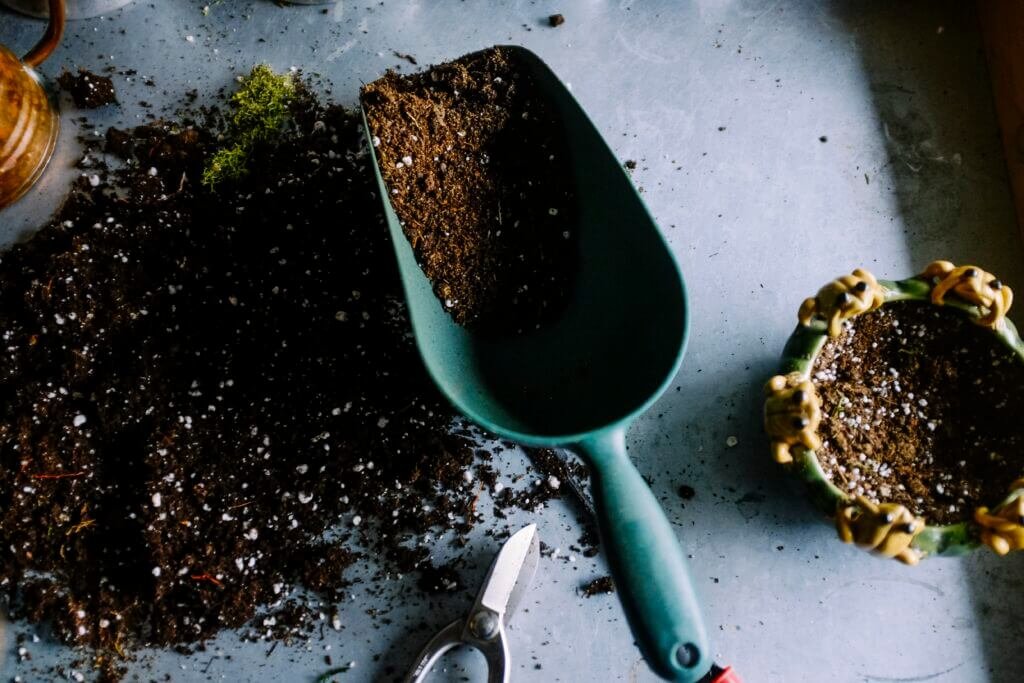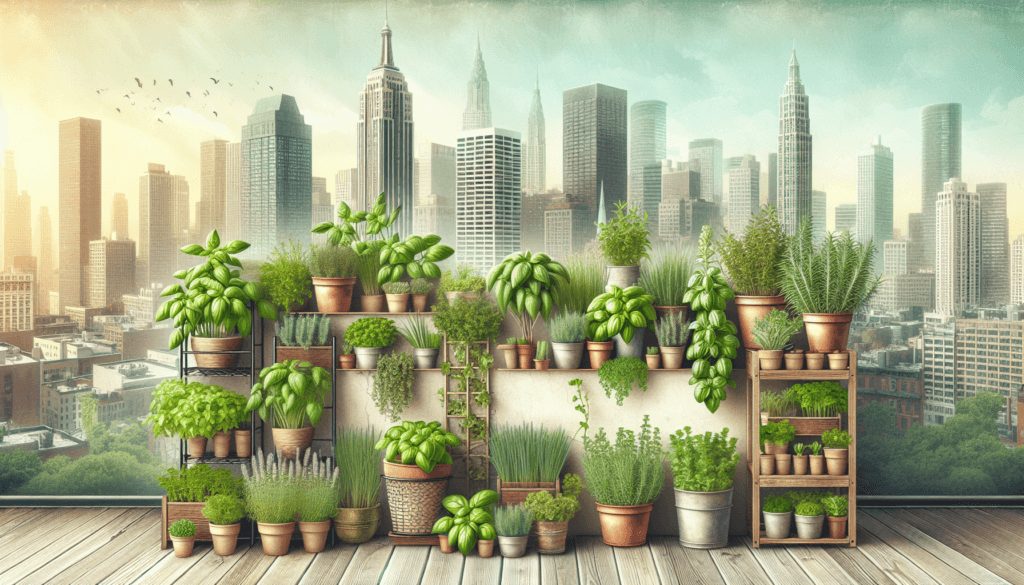Hey there! Ready to transform your urban garden into a thriving oasis of flavor and freshness? Look no further because we’ve got just the guide for you. In this article, we’ll explore the most popular herbs that are perfect for growing in your urban garden. From the distinctive aroma of basil to the zesty kick of cilantro, these herbs are not only easy to grow but will also elevate your culinary adventures to new heights. So grab your gardening gloves and get ready to unleash your green thumb because we’re about to embark on a delicious journey together!

1. Basil
Benefits of growing basil
Basil is one of the most popular herbs to grow in an urban garden, and for good reason! Not only does it add a delightful aroma and flavor to many dishes, but it also offers numerous health benefits. Basil is rich in antioxidants, which help protect your body against harmful free radicals. It also contains essential oils that have anti-inflammatory properties. Additionally, basil is a good source of vitamin K, which is important for maintaining healthy bones. Growing your own basil allows you to have a fresh supply of this versatile herb right at your fingertips.
Varieties of basil
There are several different varieties of basil to choose from, each with its own unique flavor profile. The most common variety is sweet basil, which has a slightly spicy and peppery taste. Another popular variety is Genovese basil, which is often used in traditional Italian dishes. If you’re looking for a more exotic flavor, you might consider growing Thai basil, which has a licorice-like taste. Other varieties of basil include lemon basil, cinnamon basil, and purple basil.
Tips for growing basil in an urban garden
Growing basil in an urban garden is easier than you might think. Here are some tips to help you get started:
- Choose a sunny spot: Basil thrives in full sunlight, so make sure to select a location in your garden that receives at least six hours of direct sunlight per day.
- Use well-draining soil: Basil prefers well-draining soil that is rich in organic matter. You can improve the quality of your soil by adding compost or aged manure.
- Water consistently: Basil plants like to be kept evenly moist, so make sure to water them regularly. Avoid over-watering, as this can lead to root rot.
- Trim regularly: To encourage bushy and compact growth, pinch off the tips of your basil plants regularly. This will also prevent them from flowering and going to seed too quickly.
- Harvest frequently: The more you harvest your basil, the more it will produce. When harvesting, make sure to cut just above a pair of leaves to encourage new growth.
2. Mint
Benefits of growing mint
Mint is another popular herb to grow in an urban garden, thanks to its refreshing scent and versatile uses. One of the main benefits of growing mint is its ability to aid in digestion. Mint leaves contain menthol, which helps relax the muscles of the gastrointestinal tract, easing digestion and reducing symptoms of indigestion. Mint also has antimicrobial properties that can help freshen breath and alleviate symptoms of common colds and allergies. Additionally, the aroma of mint has been shown to have mood-enhancing effects, promoting relaxation and reducing stress.
Varieties of mint
Just like basil, there are many different varieties of mint to choose from, each with its own distinct flavor. The most common variety is spearmint, which has a mild, sweet flavor. Peppermint, on the other hand, has a stronger and more minty taste. Other popular varieties include chocolate mint, apple mint, and pineapple mint. Each variety can add a unique flavor element to your culinary creations or refreshing beverages.
Tips for growing mint in an urban garden
Mint is a hardy plant that thrives in a variety of growing conditions, making it a perfect choice for urban gardens. Here are some tips to help you successfully grow mint:
- Provide some shade: While mint prefers full sunlight, it can also tolerate partial shade. If your urban garden doesn’t receive enough direct sunlight, consider planting your mint in a location that receives a few hours of shade each day.
- Choose a container: Mint has a tendency to spread and take over a garden, so it’s best to grow it in a container. This will help contain its growth and prevent it from invading other plants.
- Use well-draining soil: Mint prefers moist but well-draining soil. Adding compost or vermiculite to your potting mix can help improve drainage.
- Water regularly: Mint plants enjoy consistently moist soil, so make sure to water them regularly, especially during hot summer months. Avoid over-watering, as this can lead to root rot.
- Harvest often: Regularly harvesting your mint will encourage new growth and keep the plant bushy and compact. When harvesting, pinch off the top leaves and stems, just above a pair of leaves. This will allow the plant to continue growing and producing fresh leaves.

3. Rosemary
Benefits of growing rosemary
Rosemary is a fragrant herb that not only adds fantastic flavor to various dishes but also offers several health benefits. One of the main benefits of growing rosemary is its ability to improve brain function and enhance memory. The aroma of rosemary has been shown to stimulate cognitive activity and improve concentration and focus. Rosemary also contains antioxidants that help reduce inflammation in the body and protect against chronic diseases. Additionally, rosemary has antimicrobial properties, making it useful for treating minor wounds and preventing infections.
Varieties of rosemary
There are several varieties of rosemary to choose from, each with its own unique characteristics. The most common variety is upright rosemary, which is known for its strong flavor and aroma. Another popular variety is creeping rosemary, which has a trailing growth habit and can be grown as a groundcover. Other varieties include Tuscan Blue, Arp, and Gorizia rosemary. Each variety has its own distinct flavor profile and growth habit, allowing you to choose the one that best suits your needs.
Tips for growing rosemary in an urban garden
Growing rosemary in an urban garden can be a rewarding experience. Here are some tips to help you grow healthy rosemary plants:
- Choose a sunny spot: Rosemary thrives in full sunlight, so make sure to select a location in your garden that receives at least six hours of direct sunlight per day.
- Use well-draining soil: Rosemary prefers well-draining soil, as it doesn’t like to sit in waterlogged conditions. To improve drainage, consider adding sand or perlite to your soil mixture.
- Water sparingly: Rosemary is a fairly drought-tolerant herb and prefers to be on the dry side. Allow the soil to dry out between waterings, and be cautious not to over-water.
- Prune regularly: Pruning your rosemary plants will help maintain their shape and encourage bushy growth. Trim off the top third of the plant regularly to prevent it from becoming too leggy.
- Protect from cold temperatures: Rosemary is a Mediterranean herb that is sensitive to frost. If you live in a region with cold winters, consider growing your rosemary in a pot that can be brought indoors during the winter months.
4. Thyme
Benefits of growing thyme
Thyme is a versatile herb that offers numerous benefits when grown in an urban garden. Not only does it add a distinct flavor to various dishes, but it also has several medicinal properties. Thyme is rich in antioxidants, which help protect your body against oxidative stress and reduce inflammation. It also contains compounds that have antimicrobial properties, making it useful for treating respiratory infections and oral health issues. Thyme has also been used traditionally to alleviate digestive problems and relieve symptoms of coughs and colds.
Varieties of thyme
There are many different varieties of thyme to choose from, each with its own unique flavor and aroma. The most common variety is common thyme, also known as English thyme. It has a slightly earthy and peppery taste and is often used in hearty soups and stews. Lemon thyme, as the name suggests, has a lemony flavor and is great for poultry and seafood dishes. Other popular varieties include caraway thyme, creeping thyme, and golden thyme. Whether you’re looking for a subtle or strong flavor, there’s a variety of thyme to suit your taste.
Tips for growing thyme in an urban garden
Growing thyme in an urban garden is relatively easy, as it is a low-maintenance herb. Here are some tips to help you successfully grow thyme:
- Choose a sunny spot: Thyme thrives in full sunlight, so make sure to select a location in your garden that receives at least six hours of direct sunlight per day.
- Use well-draining soil: Thyme prefers soil that is well-draining and on the dry side. If you have heavy clay soil, consider adding sand or gravel to improve drainage.
- Water sparingly: Thyme is a drought-tolerant herb and doesn’t like to be over-watered. Allow the soil to dry out between waterings, and avoid wetting the leaves to prevent the risk of fungal diseases.
- Prune regularly: Pruning your thyme plants will help promote bushy growth and prevent them from becoming woody. Trim off the top third of the plant regularly to keep it compact and encourage new growth.
- Protect from extreme cold: While thyme is relatively hardy, it may need protection during extremely cold winters. Consider covering your thyme plants with frost cloth or bringing them indoors during frigid temperatures.

5. Parsley
Benefits of growing parsley
Parsley is a versatile herb that not only adds flavor to dishes but also offers several health benefits. One of the main benefits of growing parsley is its high nutrient content. It is a good source of vitamins A, C, and K, as well as folate and iron. Parsley also contains antioxidants that help protect against chronic diseases and support a healthy immune system. Additionally, parsley has diuretic properties, making it useful for reducing water retention and promoting kidney health.
Varieties of parsley
There are two main varieties of parsley: curly parsley and Italian flat-leaf parsley. Curly parsley has tightly curled leaves and a slightly bitter taste. It is often used as a garnish or in salads. Italian flat-leaf parsley, on the other hand, has broader leaves and a stronger flavor. It is commonly used in Mediterranean and Middle Eastern cuisines and is great for seasoning soups, stews, and sauces. Both varieties offer unique flavors and can be grown in an urban garden.
Tips for growing parsley in an urban garden
Growing parsley in an urban garden is relatively easy, as it is a tolerant herb that adapts well to different growing conditions. Here are some tips to help you grow healthy parsley plants:
- Choose a sunny spot: Parsley thrives in full sunlight, so make sure to select a location in your garden that receives at least six hours of direct sunlight per day.
- Use well-draining soil: Parsley prefers soil that is well-draining and rich in organic matter. Adding compost or aged manure to your soil can help improve its quality.
- Water consistently: Parsley likes to be kept evenly moist, so make sure to water it regularly. Avoid over-watering, as this can lead to root rot. Mulching around the plants can help retain moisture and prevent weed growth.
- Trim regularly: Regularly trimming your parsley plants will help prevent them from flowering and going to seed too quickly. It will also encourage new growth and help maintain the plant’s shape.
- Harvest from the outside: When harvesting parsley, start by picking the outer leaves first, leaving the inner leaves to continue growing. This will allow the plant to produce new leaves for future harvests.
6. Cilantro
Benefits of growing cilantro
Cilantro, also known as coriander leaves, is a popular herb with a distinct flavor. It not only adds a fresh and citrusy taste to dishes but also offers several health benefits. One of the main benefits of growing cilantro is its ability to aid in digestion. It contains enzymes that help break down food and promote healthy digestion. Cilantro also has antimicrobial properties that can help protect against foodborne illnesses. Additionally, cilantro is a good source of vitamins A and K, as well as antioxidants that help protect against chronic diseases.
Varieties of cilantro
Cilantro is a single herb with two parts: the leaves, which are known as cilantro, and the seeds, which are known as coriander. When it comes to cilantro, there is typically only one variety. However, the flavor may vary depending on the growing conditions and maturity of the plant. The leaves of cilantro have a fresh and citrusy taste, while the seeds offer a warm and slightly spicy flavor. Both parts of the plant can be used in cooking and offer unique flavors to various dishes.
Tips for growing cilantro in an urban garden
Growing cilantro in an urban garden can be a rewarding experience. Here are some tips to help you successfully grow cilantro:
- Choose a sunny spot: Cilantro thrives in full sunlight, so make sure to select a location in your garden that receives at least six hours of direct sunlight per day. It can also tolerate partial shade in hotter climates.
- Use well-draining soil: Cilantro prefers soil that is well-draining and rich in organic matter. Adding compost or aged manure can help improve the quality of your soil.
- Sow seeds directly: Cilantro is best grown from seeds, as it doesn’t transplant well. Sow the seeds directly in the garden, spacing them a few inches apart.
- Water consistently: Cilantro prefers to be kept evenly moist, so make sure to water it regularly. Avoid over-watering, as this can lead to root rot. Mulching around the plants can help retain moisture and prevent weed growth.
- Harvest frequently: Cilantro tends to bolt and go to seed quickly, especially in hot weather. To prolong the harvesting period, make sure to regularly harvest the leaves and pinch off any flower buds that appear.

7. Dill
Benefits of growing dill
Dill is a flavorful herb that offers several benefits when grown in an urban garden. One of the main benefits of growing dill is its ability to aid in digestion. Dill contains compounds that stimulate the production of digestive enzymes, helping to break down food and relieve indigestion. It also has antimicrobial properties that can help protect against foodborne illnesses. Additionally, dill is rich in antioxidants, which help protect against chronic diseases and support a healthy immune system.
Varieties of dill
Dill is a single herb with two parts: the leaves, which are used as an herb, and the seeds, which are used as a spice. When it comes to dill leaves, there is typically only one variety. However, the flavor may vary depending on the growing conditions and maturity of the plant. The leaves of dill have a fresh and slightly sweet taste. Dill seeds, on the other hand, offer a warm and aromatic flavor and are commonly used in pickling and seasoning dishes.
Tips for growing dill in an urban garden
Growing dill in an urban garden is relatively easy, as it is a low-maintenance herb. Here are some tips to help you grow healthy dill plants:
- Choose a sunny spot: Dill thrives in full sunlight, so make sure to select a location in your garden that receives at least six hours of direct sunlight per day.
- Use well-draining soil: Dill prefers soil that is well-draining and rich in organic matter. Adding compost or aged manure can help improve the quality of your soil.
- Sow seeds directly: Dill is best grown from seeds, as it doesn’t transplant well. Sow the seeds directly in the garden, spacing them a few inches apart.
- Water sparingly: Dill is a drought-tolerant herb that prefers to be on the dry side. Allow the soil to dry out between waterings, and be cautious not to over-water.
- Harvest from the outside: When harvesting dill, start by picking the outer leaves first, leaving the inner leaves to continue growing. This will allow the plant to produce new leaves for future harvests.
8. Sage
Benefits of growing sage
Sage is a fragrant herb that not only adds a savory flavor to dishes but also offers several health benefits. One of the main benefits of growing sage is its ability to improve brain function and enhance memory. Sage contains compounds that have been shown to improve cognitive function and protect against age-related cognitive decline. It also has anti-inflammatory properties that can help reduce inflammation in the body and promote overall health. Additionally, sage has antimicrobial properties, making it useful for treating minor wounds and preventing infections.
Varieties of sage
There are several different varieties of sage to choose from, each with its own unique flavor and appearance. The most common variety is common sage, which has a strong and earthy flavor. Another popular variety is pineapple sage, which has a fruity and tropical taste. Other varieties include purple sage, tricolor sage, and Clary sage. Each variety offers a distinct flavor profile and can be used in a variety of culinary and medicinal applications.
Tips for growing sage in an urban garden
Growing sage in an urban garden is relatively easy, as it is a hardy and low-maintenance herb. Here are some tips to help you successfully grow sage:
- Choose a sunny spot: Sage thrives in full sunlight, so make sure to select a location in your garden that receives at least six hours of direct sunlight per day.
- Use well-draining soil: Sage prefers soil that is well-draining and on the dry side. If you have heavy clay soil, consider adding sand or gravel to improve drainage.
- Water sparingly: Sage is a drought-tolerant herb and prefers to be on the dry side. Allow the soil to dry out between waterings, and avoid over-watering.
- Prune regularly: Pruning your sage plants will help maintain their shape and encourage bushy growth. Trim off the top third of the plant regularly to prevent it from becoming too leggy.
- Protect from extreme cold: While sage is relatively hardy, it may need protection during extremely cold winters. Consider covering your sage plants with frost cloth or bringing them indoors during frigid temperatures.

9. Oregano
Benefits of growing oregano
Oregano is a flavorful herb that not only adds a distinct taste to dishes but also offers several health benefits. One of the main benefits of growing oregano is its high antioxidant content. Oregano is rich in compounds such as rosmarinic acid and thymol, which have been shown to have antimicrobial and anti-inflammatory properties. It also contains vitamins A, C, and E, as well as minerals such as iron and manganese. Additionally, oregano has traditionally been used to alleviate symptoms of respiratory conditions and promote overall digestive health.
Varieties of oregano
There are many different varieties of oregano to choose from, each with its own unique flavor and aroma. The most common variety is Greek oregano, which has a strong and robust flavor. Another popular variety is Italian oregano, which has a milder and slightly sweeter taste. Mexican oregano, on the other hand, has a citrusy and slightly spicy flavor. Other varieties include Syrian oregano, Cretan oregano, and Cuban oregano. Each variety offers distinct flavor profiles that can enhance a variety of culinary creations.
Tips for growing oregano in an urban garden
Growing oregano in an urban garden is relatively easy, as it is a hardy herb that thrives in a variety of conditions. Here are some tips to help you successfully grow oregano:
- Choose a sunny spot: Oregano thrives in full sunlight, so make sure to select a location in your garden that receives at least six hours of direct sunlight per day.
- Use well-draining soil: Oregano prefers soil that is well-draining and on the dry side. Adding sand or perlite to your soil mixture can help improve drainage.
- Water sparingly: Oregano is a drought-tolerant herb and prefers to be on the dry side. Allow the soil to dry out between waterings, and avoid over-watering.
- Prune regularly: Pruning your oregano plants will help maintain their shape and encourage bushy growth. Trim off the top third of the plant regularly to prevent it from becoming too leggy.
- Divide regularly: Oregano can become crowded over time, so it’s a good idea to divide the plants every two to three years. This will help rejuvenate the plants and promote healthier growth.
10. Chives
Benefits of growing chives
Chives are a versatile herb that not only adds a mild onion flavor to dishes but also offers several health benefits. One of the main benefits of growing chives is their high nutrient content. Chives are a good source of vitamins A, C, and K, as well as folate and minerals such as iron and calcium. They also contain antioxidants that help protect against chronic diseases and support a healthy immune system. Additionally, chives have traditionally been used to promote digestive health and alleviate symptoms of respiratory conditions.
Varieties of chives
There are two main varieties of chives: common chives and garlic chives. Common chives have thin and tubular leaves with a mild onion flavor. They are commonly used as a garnish or to add a subtle onion taste to dishes. Garlic chives, on the other hand, have flat leaves and a stronger garlic flavor. They are often used in Asian cuisines and can be cooked or eaten raw. Both varieties of chives offer unique flavors and can be a great addition to an urban garden.
Tips for growing chives in an urban garden
Growing chives in an urban garden is relatively easy, as they are tolerant herbs that adapt well to different growing conditions. Here are some tips to help you grow healthy chive plants:
- Choose a sunny spot: Chives thrive in full sunlight, so make sure to select a location in your garden that receives at least six hours of direct sunlight per day.
- Use well-draining soil: Chives prefer soil that is well-draining and on the slightly alkaline side. Adding compost or aged manure can help improve the quality of your soil.
- Water consistently: Chive plants enjoy consistently moist soil, so make sure to water them regularly. Avoid over-watering, as this can lead to root rot. Mulching around the plants can help retain moisture and prevent weed growth.
- Divide regularly: Chives tend to clump and become crowded over time. To rejuvenate the plants and promote healthier growth, divide them every two to three years.
- Harvest from the outside: When harvesting chives, start by cutting the outer leaves first, leaving the inner leaves to continue growing. This will allow the plant to produce new leaves for future harvests.
In conclusion, growing herbs in your urban garden can be a rewarding experience. Not only do they add a burst of flavor to dishes, but they also offer numerous health benefits. Whether you choose to grow basil, mint, rosemary, thyme, parsley, cilantro, dill, sage, oregano, or chives, each herb will bring its own unique qualities to your garden and culinary creations. By following the tips and guidelines provided for each herb, you can successfully grow a variety of herbs in your urban garden and enjoy the many benefits they have to offer. So, don’t hesitate to get started on your herb garden journey and elevate your cooking and well-being with these popular herbs!


